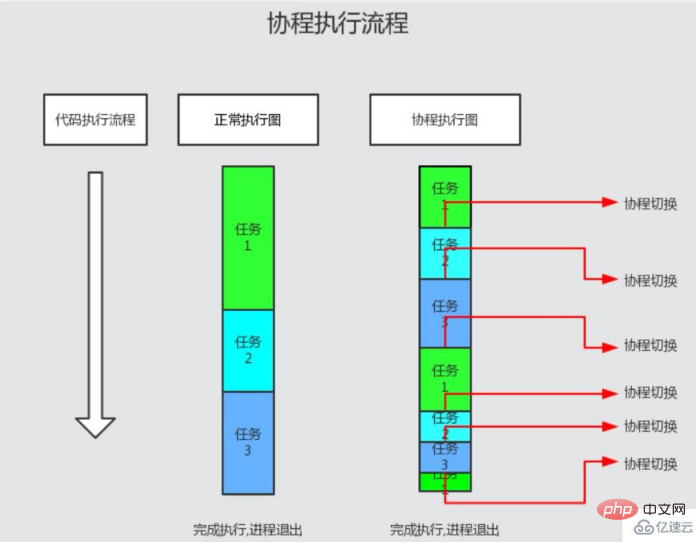在swoole中,Swoole server接收数据在worker进程触发onReceive回调,产生一个协程,Swoole为每个请求创建对应携程,协程中也能创建子协程,协程在底层实现上是单线程的,因此同一时间只有一个协程在工作。

本教程操作环境:Windows10系统、Swoole4版、DELL G3电脑
什么是进程?
进程就是应用程序的启动实例。独立的文件资源,数据资源,内存空间。
什么是线程?
线程属于进程,是程序的执行者。一个进程至少包含一个主线程,也可以有更多的子线程。线程有两种调度策略,一是:分时调度,二是:抢占式调度。
什么是协程?
协程是轻量级线程,协程也是属于线程,协程是在线程里执行的。协程的调度是用户手动切换的,所以又叫用户空间线程。协程的创建、切换、挂起、销毁全部为内存操作,消耗是非常低的。协程的调度策略是:协作式调度。
Swoole 协程的原理
Swoole4 由于是单线程多进程的,同一时间同一个进程只会有一个协程在运行。
Swoole server 接收数据在 worker 进程触发 onReceive 回调,产生一个携程。Swoole 为每个请求创建对应携程。协程中也能创建子协程。
协程在底层实现上是单线程的,因此同一时间只有一个协程在工作,协程的执行是串行的。
因此多任务多协程执行时,一个协程正在运行时,其他协程会停止工作。当前协程执行阻塞 IO 操作时会挂起,底层调度器会进入事件循环。当有 IO 完成事件时,底层调度器恢复事件对应的协程的执行。。所以协程不存在 IO 耗时,非常适合高并发 IO 场景。(如下图)

Swoole 的协程执行流程
协程没有 IO 等待 正常执行 PHP 代码,不会产生执行流程切换
协程遇到 IO 等待 立即将控制权切,待 IO 完成后,重新将执行流切回原来协程切出的点
协程并行协程依次执行,同上一个逻辑
协程嵌套执行流程由外向内逐层进入,直到发生 IO,然后切到外层协程,父协程不会等待子协程结束
协程的执行顺序
先来看看基础的例子:
1 2 3 |
|
go() 是 \Co::create() 的缩写, 用来创建一个协程, 接受 callback 作为参数, callback 中的代码, 会在这个新建的协程中执行.
备注: \Swoole\Coroutine 可以简写为 \Co
上面的代码执行结果:
1 2 3 |
|
执行结果和我们平时写代码的顺序, 好像没啥区别. 实际执行过程:
运行此段代码, 系统启动一个新进程
遇到 go(), 当前进程中生成一个协程, 协程中输出 heelo go1, 协程退出
进程继续向下执行代码, 输出 hello main
再生成一个协程, 协程中输出heelo go2, 协程退出
运行此段代码, 系统启动一个新进程. 如果不理解这句话, 你可以使用如下代码:
1 |
|
执行并使用 ps aux 查看系统中的进程:
1 2 3 |
|
我们来稍微改一改, 体验协程的调度:
1 2 3 4 5 6 7 8 |
|
怎么不是顺序执行的呢? 实际执行过程:
运行此段代码, 系统启动一个新进程
遇到 go(), 当前进程中生成一个协程
协程中遇到 IO阻塞 (这里是 Co::sleep() 模拟出的 IO等待), 协程让出控制, 进入协程调度队列
进程继续向下执行, 输出 hello main
执行下一个协程, 输出 hello go2
之前的协程准备就绪, 继续执行, 输出 hello go1
到这里, 已经可以看到 swoole 中 协程与进程的关系, 以及 协程的调度, 我们再改一改刚才的程序:
1 2 3 4 5 |
|
我想你已经知道输出是什么样子了:
1 2 3 |
|
推荐学习: swoole教程
以上就是swoole协程的实现原理是什么的详细内容,更多请关注php中文网其它相关文章!

每个人都需要一台速度更快、更稳定的 PC。随着时间的推移,垃圾文件、旧注册表数据和不必要的后台进程会占用资源并降低性能。幸运的是,许多工具可以让 Windows 保持平稳运行。




Copyright 2014-2025 https://www.php.cn/ All Rights Reserved | php.cn | 湘ICP备2023035733号